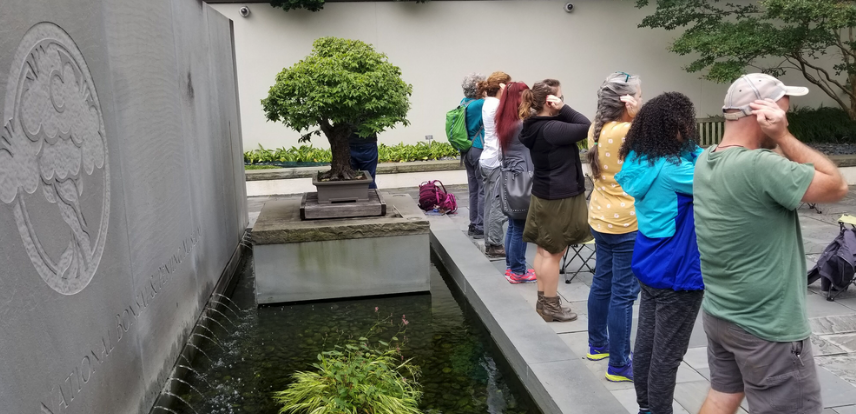“When you forest bathe in the National Bonsai and Penjing Museum, you can sense the extraordinary magic of these tiny trees that have been lovingly tended by so many generations of human hands in Asia, and now here,” she said.
One might be caught off guard when they hear the term “forest bathing.” Someone who participates in forest bathing does indeed cleanse themselves amid trees and plants, but the practice doesn’t require a bathtub. We sat down with certified nature and forest therapy guide and acclaimed author (The Joy of Forest Bathing—Reconnect with Wild Places & Rejuvenate Your Life), Melanie Choukas-Bradley, who will lead the upcoming Forest Bathing Amongst the Bonsai classes at the Museum (April 18th and May 2nd, October 3rd) to learn more about the the practice and what participants can look forward to.
Melanie leads a class at The National Bonsai & Penjing Museum. (Photo By: Ana Ka'ahanui)
Shinrin-yoku, or forest bathing, is a therapeutic experience during which one bathes in the forest atmosphere by immersing their senses in the natural world.
Certified nature and forest therapy guide Melanie Choukas-Bradley spent much of her childhood roaming Vermont’s vast woods and fields. So when she first read about forest bathing in a 2014 issue of O, The Oprah Magazine, the concept of full sensory immersion in the beauty and wonder of nature immediately resonated with her.
“Forest bathing simply gives a name to an experience I've always valued: quiet time surrounded by natural beauty,” she said.
The article inspired Choukas-Bradley to travel to California and walk with Amos Clifford, the founder of the Association of Nature and Forest Therapy. Her time with Clifford led her to train as a forest therapy guide, and she received her certification from ANFT in 2016.
As a naturalist and nature book author, Choukas-Bradley has led nature walks for many years. She said every guide who has led forest bathing walks she participated in, both in North America and in Japan, has bolstered love for nature.
“I'm inspired by everyone who shares their love of nature,” Choukas-Bradley said. “I’m especially inspired by the beauty and wonder of nature itself.”
But forest bathing is more than just a walk in the park, she said. The phenomenon allows one to slow down, turn off your phone, breathe deeply and absorb nature’s beauty.
Choukas-Bradley said the “remarkably enjoyable and restorative” natural therapy can be likened to meditation, tai chi, yoga and other mindfulness practices, but additionally helps one to form a close relationship with nature.
“We are all stressed by the constant barrage of news flowing from our electronic devices and our lengthy personal to do lists,” she said. “This brings joy and well-being.”
A class cups their ears to heighten the sound of the water fountain at the National Bonsai & Penjing Museum. (Photo By: Ana Ka'ahanui)
Forest bathing has led Choukas-Bradley across the United States, from D.C. to Texas to Colorado. But she said bathing fully revolves around appreciating each moment and taking the time to connect with your surroundings, no matter where you are.
”If you're able to be fully present in nature, you can forest bathe anywhere, including in your own backyard,” she said.
Choukas-Bradley added that offering forest bathing walks among bonsai trees fuses two classic Japanese nature practices: appreciation for bonsai trees themselves, but also shinrin-yoku, or forest bathing.
“When you forest bathe in the National Bonsai and Penjing Museum, you can sense the extraordinary magic of these tiny trees that have been lovingly tended by so many generations of human hands in Asia, and now here,” she said.
Choukas-Bradley’s forest bathing sessions will be held at the Museum April 18, May 2 and Oct. 3. Click here to buy tickets now for one or more dates.










